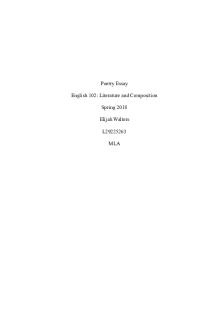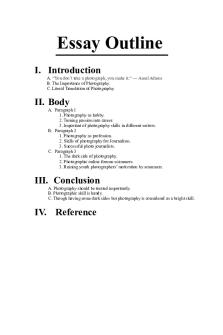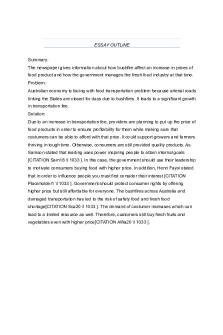Poetry Essay Theisis, Outline, and Final Essay PDF

| Title | Poetry Essay Theisis, Outline, and Final Essay |
|---|---|
| Author | Anonymous User |
| Course | Composition and Literature |
| Institution | Liberty University |
| Pages | 6 |
| File Size | 98.6 KB |
| File Type | |
| Total Downloads | 61 |
| Total Views | 134 |
Summary
Poetry Essay explaining Ode to a Nightingale by John Keates....
Description
Poetry Thesis and Outline ENGL 102: Literature and Composition Fall B 2021 NAME: Rayven Woods ID # L30773735 APA
Woods 2 Rayven Woods Prof. Stephanie A. Hobson ENGL 102-B21 20 September 2021 Thesis and Outline Thesis: “Ode to a Nightingale” is a poem by John Keates. John Keates uses many different literary devices to show the true theme of this poem however there is not just one theme. I.
The first literary device that Keates uses is imagery. When the first reader begins the poem, they will be able to insert themselves in the exact setting. a. Themes of this poem include mortality and accepting that everyone must die b. Sound/Visual c. Setting
II.
Symbolism a. Death b. Nightingale
III.
Mood/Tone a. Envious b. Frustration
BEGIN ESSAY ON A NEW PAGE
Woods 3 Rayven Woods Prof. Stephanie A. Hobson ENGL 102-B21 27 September 2021 Analysis of “Ode to a Nightingale” People have used stories to pass down lessons throughout generations, but poems could say the same. Poetry has a way of expressing different ideas using imagery, metaphors, similes, and many other literary devices. In the 1800s, poet John Keates wrote a poem titled "Ode to a Nightingale." Some would describe this poem as grim and dark, but this is the reality for many people. The central theme of this poem is mortality and how everyone must accept that they will die. The first literary device that Keates uses is imagery; however, his multiple uses of imagery allow the reader to understand the speaker. When the reader begins the poem, they will be able to insert themselves in the exact setting. In the first couple of lines, Keates uses imagery to express his desire to numb his senses. Lines 43-45 describe an area with thick grass and fruit trees using imagery; the reader can place the setting of this poem inside a forest. Keates also uses tone to express further the theme of accepting mortality. The tone seen in this poem includes reflective melancholy, which helps set the mood of envious and frustration. The speaker sees the correlation between themselves and the bird. "Tis not through envy of thy happy lot, / But being too happy in thine happiness" (5-6). In this line, the speaker admits that they are happy for the bird but later shows envy. " Fade far away, dissolve, and quite forget /What thou among the leaves hast never known" (21-22). In the whole third stanza, the speaker
Woods 4 expresses why they are envious of the life of the Nightingale, and it is because the bird does not have to experience things that humans deal with, such as pain and sickness. John Keates also utilizes symbolism to express further the theme of mortality to the reader throughout this poem. The title of this poem is symbolic because of what the reader learns the Nightingale symbolizes. By the end of the poem, Nightingale symbolizes what the speaker wishes humans can be immortality. In line 61, the speaker practically screams at the bird that it was not born to die like humans. "Darkling I listen; and, for many a time / I have been half in love with easeful Death" (51-52). In these lines, death does not mean death like the reader is used to, but it does symbolize passage to a place where the speaker is free of all mortal problems. In the second to last stanza, Keates places the final form of symbolism. Keates uses symbolism to explain that the speaker wishes that he/she could live a peaceful life throughout this entire poem. The following lines symbolize an enchanting escape into a world that the speaker is not familiar with: The same that oft-times hath Charm'd magic casements, opening on the foam Of perilous seas, in faery lands forlorn. (68-70) In conclusion, this poem is significant because it allows the reader to contemplate life and death. This poem utilizes imagery and other literary devices to express that the speaker understands that everyone must die ultimately, but we should live without restrictions during life, just like the Nightingale. As the reader, it is evident by the end of the poem that the speaker is unaware of what is genuine or his/her imagination. "Ode to a Nightingale" provokes its' readers to ask themselves questions about their life that they may not have thought to ask before. This poem that many see as grim and sad is enlightening because while humans cannot be free of pain and
Woods 5 sickness, they can limit the boundaries and restrictions they put on themselves. This poem continues to be taught and analyzed throughout the ages because it is the realization that all humans must realize.
Woods 6 Works Cited Ode to a Nightingale by John Keats | Poetry Foundation. Poetry Foundation. (2021). Retrieved 27 September 2021, from https://www.poetryfoundation.org/poems/44479/ode-toa-nightingale....
Similar Free PDFs

Essay Outline and References Final
- 10 Pages

Poetry Essay - Grade: A+
- 5 Pages

Poetry Analysis Essay Examples
- 7 Pages

Essay Blazon poetry
- 2 Pages

Essay Poetry - Grade: A
- 3 Pages

Chimney Sweeper Poetry Essay
- 4 Pages

Poetry Essay - Grade: 80%
- 6 Pages

Poetry Essay - Grade: B
- 5 Pages

Essay Outline
- 2 Pages

Essay Outline
- 1 Pages

Essay outline
- 3 Pages

Essay Outline
- 2 Pages

Essay Outline
- 3 Pages
Popular Institutions
- Tinajero National High School - Annex
- Politeknik Caltex Riau
- Yokohama City University
- SGT University
- University of Al-Qadisiyah
- Divine Word College of Vigan
- Techniek College Rotterdam
- Universidade de Santiago
- Universiti Teknologi MARA Cawangan Johor Kampus Pasir Gudang
- Poltekkes Kemenkes Yogyakarta
- Baguio City National High School
- Colegio san marcos
- preparatoria uno
- Centro de Bachillerato Tecnológico Industrial y de Servicios No. 107
- Dalian Maritime University
- Quang Trung Secondary School
- Colegio Tecnológico en Informática
- Corporación Regional de Educación Superior
- Grupo CEDVA
- Dar Al Uloom University
- Centro de Estudios Preuniversitarios de la Universidad Nacional de Ingeniería
- 上智大学
- Aakash International School, Nuna Majara
- San Felipe Neri Catholic School
- Kang Chiao International School - New Taipei City
- Misamis Occidental National High School
- Institución Educativa Escuela Normal Juan Ladrilleros
- Kolehiyo ng Pantukan
- Batanes State College
- Instituto Continental
- Sekolah Menengah Kejuruan Kesehatan Kaltara (Tarakan)
- Colegio de La Inmaculada Concepcion - Cebu


